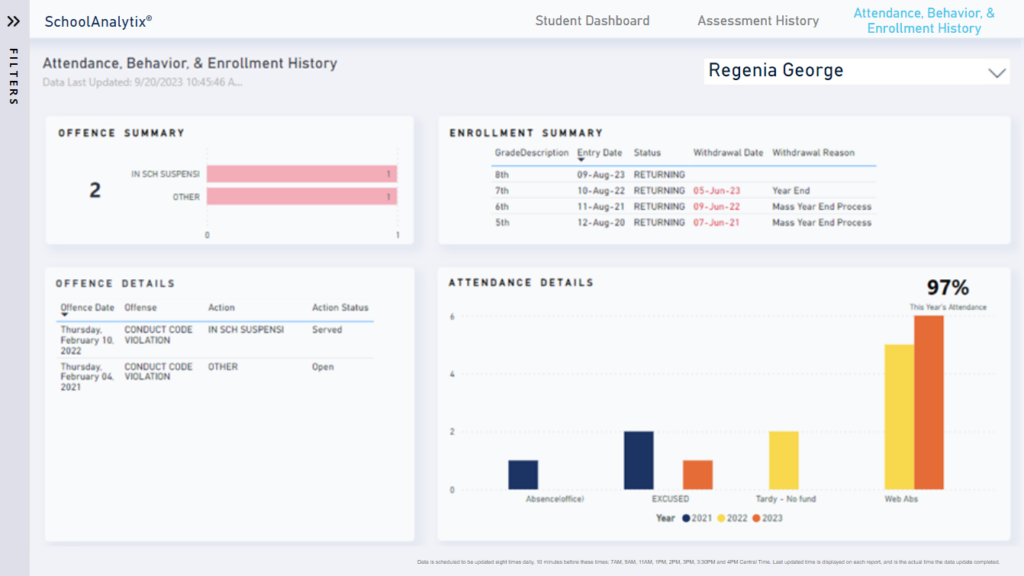In today’s educational landscape, data has become a valuable asset for educators seeking to enhance student learning outcomes and improve school performance. By harnessing data from various sources, including enrollment records, behavior incidents, and assessment history, educators can gain valuable insights into student needs, preferences, and progress. These insights empower educators to make informed decisions that drive positive change in the classroom and beyond. In this article, we will explore how educators can leverage enrollment, behavior, and assessment data to drive decision-making and improve educational outcomes for all students.
Understanding the Value of Data in Education
Data has the power to transform education by providing educators with valuable insights into student performance, behavior, and engagement. By collecting, analyzing, and interpreting data, educators can:
Identify Patterns and Trends: Data allows educators to identify patterns and trends in student behavior and performance over time. By analyzing enrollment trends, behavior incidents, and assessment scores, educators can identify areas for improvement and develop targeted interventions to address student needs.
Personalize Instruction: Data enables educators to personalize instruction based on individual student needs and preferences. By understanding each student’s learning style, strengths, and weaknesses, educators can tailor instruction to meet the diverse needs of their students and maximize learning outcomes.
Monitor Progress: Data allows educators to monitor student progress in real-time and track growth over time. By regularly assessing student performance and behavior, educators can identify areas of strength and areas for improvement and adjust instruction accordingly.
Inform Decision-Making: Data provides educators with valuable information to inform decision-making at the classroom, school, and district levels. By analyzing enrollment, behavior, and assessment data, educators can make informed decisions about curriculum, instructional strategies, resource allocation, and school policies.
Leveraging Enrollment Data
Enrollment data provides educators with valuable information about student demographics, course enrollment patterns, and class sizes. By analyzing enrollment data, educators can:
- Identify demographic trends and disparities in enrollment, such as differences in enrollment rates among students of different racial/ethnic backgrounds or socioeconomic status.
- Monitor class sizes and make adjustments to ensure equitable access to resources and opportunities for all students.
- Track student course enrollment patterns and identify trends in course selection, such as popular courses or courses with low enrollment rates.
- Identify students who may be at risk of dropping out or disengaging from school and implement targeted interventions to support their success.
Utilizing Behavior Data
Behavior data provides educators with insights into student conduct, discipline incidents, and classroom dynamics. By analyzing behavior data, educators can:
- Identify patterns and trends in student behavior, such as recurring discipline incidents or disruptive behavior patterns.
- Identify students who may be struggling with social-emotional issues or behavioral challenges and implement targeted interventions to support their social and emotional wellbeing.
- Monitor the effectiveness of behavior management strategies and interventions and make adjustments as needed to promote positive behavior and a supportive learning environment.
- Identify students who may be at risk of academic failure or disengagement due to behavioral issues and provide additional support and resources to help them succeed.
Analyzing Assessment History
Assessment data provides educators with insights into student academic performance, growth, and achievement. By analyzing assessment data, educators can:
- Identify student learning gaps and areas of weakness and develop targeted interventions to address these areas.
- Monitor student progress towards academic goals and track growth over time.
- Identify trends in student performance, such as improvements or declines in performance over time, and adjust instruction accordingly.
- Monitor the effectiveness of instructional strategies and curriculum materials and make adjustments as needed to improve student learning outcomes.
Integrating Data into Decision-Making
To effectively harness the power of enrollment, behavior, and assessment data, educators must integrate data into their decision-making processes:
Data Collection and Analysis: Educators should collect, analyze, and interpret data from multiple sources, including enrollment records, behavior incidents, and assessment scores. By combining data from various sources, educators can gain a more comprehensive understanding of student needs, preferences, and progress.
Collaborative Decision-Making: Educators should collaborate with colleagues, administrators, and other stakeholders to analyze data, identify trends, and develop data-informed strategies and interventions. By working together, educators can leverage their collective expertise and experience to make informed decisions that benefit all students.
Data-Informed Instruction: Educators should use data to inform their instructional practices, curriculum development, and classroom management strategies. By tailoring instruction to meet the diverse needs of their students and addressing learning gaps identified through data analysis, educators can maximize learning outcomes and promote student success.
Continuous Improvement: Educators should continuously monitor student progress, evaluate the effectiveness of interventions, and adjust strategies as needed to improve student outcomes. By embracing a culture of continuous improvement and data-driven decision-making, educators can create a supportive learning environment where all students can thrive.
Conclusion
In conclusion, enrollment, behavior, and assessment data provide educators with valuable insights into student needs, preferences, and progress. By harnessing the power of data and integrating it into their decision-making processes, educators can make informed decisions that drive positive change in the classroom and beyond. By analyzing enrollment data, educators can identify trends in student enrollment patterns and ensure equitable access to resources and opportunities for all students. By analyzing behavior data, educators can identify students who may be struggling with social-emotional issues or behavioral challenges and provide targeted interventions to support their success. By analyzing assessment data, educators can identify learning gaps and areas of weakness and develop targeted interventions to address these areas. Ultimately, by embracing a culture of continuous improvement and data-driven decision-making, educators can create a supportive learning environment where all students can thrive and succeed.

